Switching from backhand to forehand strokes, or forehand to backhand strokes, is a key skill in table tennis.
Too often when players practice, they spend too much time only playing crosscourt (either forehand to forehand or backhand to backhand). So they get very good at playing lots of forehands in a row, or lots of backhands in a row.
But during matches, the direction of play switches frequently. Rarely will your opponent play the ball to the same position for two consecutive shots. And this is where some players become unstuck. They may have good forehand strokes and good backhands strokes, but they struggle to make the transition between the two and make mistakes.
In this blog post, I explain how to improve switching between forehand and backhand strokes and share five simple training drills. As an extra bonus (lucky you!) there’s a video demonstration of each training drill featuring myself and Nila, a player who I coach.
How to improve your switching
For me, there are four key elements for a good switch between forehand and backhand strokes:
1. Recover to the neutral position – If you play a shot and leave your bat in either the forehand or backhand position, it is harder to get into position for the next ball if your opponent switches the direction of play. Instead, try to finish all of your strokes with your bat in front of you, in the centre of your body (the neutral position). This puts you in a very good position to play either forehand or backhand for the next ball.
2. Keep your grip relaxed – If you hold the bat too tightly, it’s much harder to turn your wrist and change your bat angle when switching between forehand and backhand. This is especially true if you like to topspin the ball, as you need to close your bat angle more. The motion of switching between forehand and backhand topspins is a little bit like a figure of eight. You can only really do this motion effectively if your wrist is loose and relaxed. If your wrist is too tight, you will find it difficult to turn your bat angle enough.
3. Move your feet – Too often I see players reaching for the ball when the direction of play is switched. They may still hit the ball, but their shot is weak or they make an error. Instead of reaching for the ball you should move your feet to get your body in a better position to play the shot effectively. This is physically more demanding than standing still and reaching, but your consistency will improve significantly.
4. Watch your opponent – The more you play table tennis, the better you will get at reading your opponent. But it’s a habit you can start any time. Your opponent will give you clues about where they are going to play the ball. The position of their body and shoulders, the direction their arm is moving and the angle of their wrist all gives information about where the ball is likely to go. Watching your opponent can give you that little bit of extra time to work out if the ball will be played to your forehand or backhand. You can then move into position quicker and be ready to play a good shot.
Training drills
The most important part of being good at switching between forehand and backhand strokes is practice. As I noted in the introduction, too often players spend too long practicing either forehand to forehand or backhand to backhand.
During your next practice session, try one or more of these simple (but effective!) training drills instead…
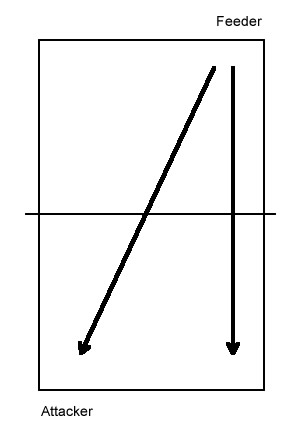
1 x forehand, 1 x backhand
A very simple training drill to begin with. This is quite a good warm-up, as it gets your feet moving and you can practice switching between forehand and backhand without any real pressure.
Drill explanation:
- The feeder plays 1 ball to the attacker’s forehand and 1 ball to the attacker’s backhand.
- The attacker plays both forehand and backhand shots to the feeder’s backhand.
- The feeder should block the ball and the attacker should play a drive or topspin.
- The feeder can make the drill harder by blocking quicker or blocking to wider angles.
Video demonstration:
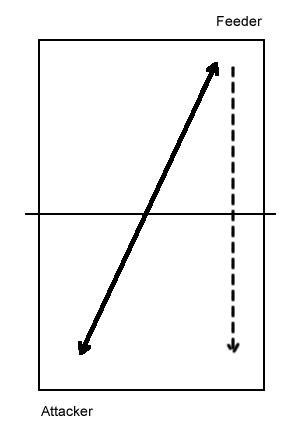
Backhand to backhand, random switch to forehand
This is a very good drill to practice watching your opponent. It is harder than the the first drill, as their is an irregular element to it. The feeder controls when the ball is switched from backhand to forehand. If you lose concentration or start day-dreaming, you’ll be in big trouble!
Drill explanation:
- Start the rally by playing backhand to backhand crosscourt.
- The feeder decides when to switch to the attacker’s forehand.
- When the ball is switched, the attacker plays one forehand to the feeder’s backhand.
- The rally then returns backhand to backhand until the feeder switches again.
Video demonstration:
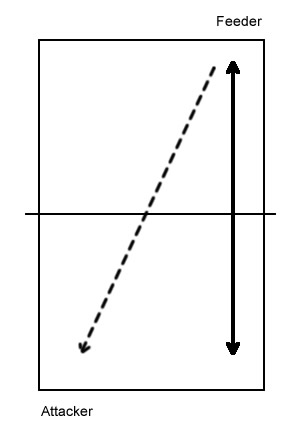
Forehand down the line, random switch to backhand
This drill is very similar to the previous drill. Except this time the random switch is to the backhand. A lot of players (myself included) tend to be better at switching from backhand to forehand, but not so strong at switching from forehand to backhand. So it’s definitely worth doing this drill too.
Drill explanation:
- The feeder plays backhands down the line. The attacker plays forehands down the line.
- The feeder decides when to switch to the attacker’s backhand.
- When the ball is switched, the attacker plays one backhand to the feeder’s backhand.
- The rally then returns to backhand (feeder) to forehand (attacker) until the feeder switches again.
Video demonstration:
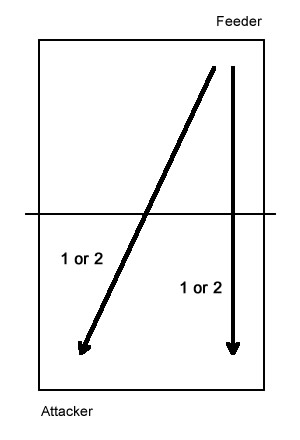
1 or 2 forehands, 1 or 2 backhands
This drill is harder. There is a lot of switching with an element of irregularity. You don’t know if the ball is going to be switched on the first or second ball, so you always have to watch your opponent and recover to the neutral position after every stroke.
Drill explanation:
- The feeder plays 1 or 2 balls to the attacker’s backhand and then 1 or 2 balls to the attacker’s forehand.
- The attacker plays all shots to the feeder’s backhand.
- The feeder should block the ball and the attacker should play a drive or topspin.
- The feeder can make the drill harder by blocking to different positions on the backhand and forehand sides.
Video demonstration:
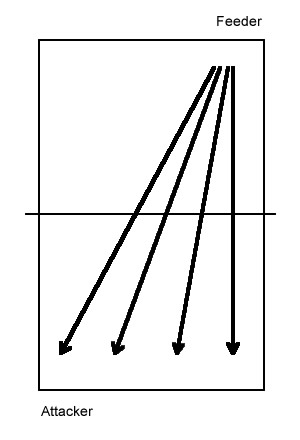
Forehand or backhand (random)
This is the hardest drill. This time the feeder can play the ball to any position on the table and the attacker has to keep the rally going for as long as possible. My top tip for this drill is to start slowly. Focus on consistency first. When you can keep the rally going for 15-20 shots, gradually increase the speed of your shots.
Drill explanation:
- The feeder can play the ball to any position on the table.
- The attacker plays all shots to the feeder’s backhand.
- The feeder should block the ball and the attacker should play a drive or topspin.
- You can make the drill harder by playing quicker.
Video demonstration:

